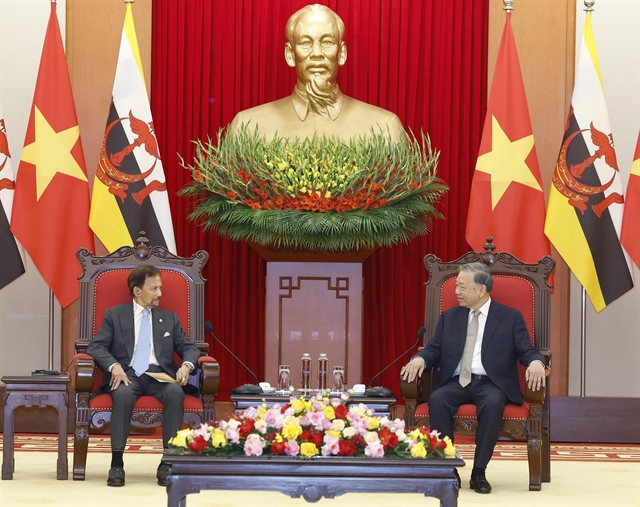 Economy
Economy

Hà Nội is calling on colossal investment of about VNĐ2.6 quadrillion (US$115.5 billion) over the next five years as the first step in transforming itself into the second Singapore, announced top officials.
 |
| Skyscrapers bloom along Phạm Hùng Street in Cầu Giấy District, Hà Nội. Hà Nội is requesting a colossal amount of about US$115.5 billion over the next five years to mostly invest in urban infrastructure. - VNS Photo Thái Hà |
HÀ NỘI – Hà Nội is calling on colossal investment of about VNĐ2.6 quadrillion (US$115.5 billion) over the next five years as the first step in transforming itself into the second Singapore, announced top officials.
The figure was made public in the first and biggest conference on the city’s investment and development vision held on Saturday. The conference attracted some 600 participants including Government officials, domestic and foreign enterprise representatives as well as heads of international organisations and economic experts.
The conference was held barely three months after new top leaders in Hà Nội came into office.
Such a large figure of investment will largely depend on the private and the FDI sectors – as much as 80 per cent – while the city budget will only focus on frame infrastructure projects or projects in fields that are exclusively under State control like security or national defence, said Hà Nội People’s Committee Chairman Nguyễn Đức Chung.
“The city especially appreciates and calls on investment from the private sector under multiple models,” Chung said.
Infrastructure – one of the 1000-year-old capital’s key investment directions – will get a gigantic amount of money poured into various fields ranging from roads and the drainage network to the power grid and telecommunications in the next five years and is expected to continue on at least until 2050, according to the Hà Nội urban master plan.
Hà Nội, for the first time, has had its most detailed urban master plan to 2030 with a vision stretching to 2050, in which a city centre and five satellite towns will be fully connected and provide support to each other for collective growth and development.
The city has so far listed 52 projects under the Public-Private Partnership (PPP) model calling out for investment in the next five years and another 43 projects to be funded by the private sector. They were estimated at VNĐ338.7 trillion ($15 billion) and VNĐ372.2 trillion ($16.5 billion) respectively.
“There have been 70 investors lined up to invest in those projects,” Chung said.
Financial hub
Hà Nội is setting its eyes on transforming itself into a global financial hub like Hong Kong and Singapore after 2030, said Minister of Planning and Investment Nguyễn Chí Dũng at the conference.
Dũng also predicted the capital to become a mega city in less than 20 years due to the current high urbanisation speed and a constant increase of the city population.
The number of city inhabitants was projected to hit about nine million by 2030, a 40 per cent increase from 6.5 million back in 2009.
Such urban population density has forced Hà Nội to divert its development focus from the city centre to its edges in order to reduce traffic jams and alleviate pressures on the centre’s infrastructure, he said.
“Edge-oriented development with five satellite towns will also open the door for investors in infrastructure, transport and real estate sectors,” he said.
Yet the minister called on the capital to act more on administrative and investment reforms so that it could “pump the financial blood to Hà Nội’s enterprises as well as the whole country”.
“We have to make Hà Nội a financial hub shoulder-to-shoulder with Hong Kong and Singapore,” he said.
Challenges
Prime Minister Nguyễn Xuân Phúc supported the rising role of the private sector in the market, showing more determination in minimising the State-owned enterprises’ economic involvement.
“What the market does better, let the market do,” he said at the conference.
“The Government instead should focus more on building institutions and restrict intervention into the economic activities by administrative means.”
As Việt Nam approaches the status of a middle-income country, its access to grants and official development assistance (ODA) loans are gradually declining, said the ADB Country Director for Việt Nam Eric Sidgwick.
“Borrowing pressures have begun to mount and public debt has been approaching the limits of sustainability,” he said.
The public debt issue has triggered heated debates in the country when it climbed to 62.2 per cent of GDP last year. Though yet to cross the red line of 65 per cent set by the National Assembly, Việt Nam’s public debt still tops other ASEAN nations’ and will likely be the only country in the bloc to reach 68 per cent by 2020, according to the International Monetary Fund (IMF).
In times of such funding difficulties, Sidgwick said that the private sector’s investment should be a solution, especially the PPP model.
“However, a clear and transparent procurement process for investor selection is needed to give investors’ confidence and opportunities to reduce the costs and associated risks,” he said.
United States Embassy to Việt Nam Chargé d’Affaires ad interim Susan M. Sutton, meanwhile, pointed out that doing business in Hà Nội “can be difficult”.
“Transparency issues; long and convoluted licensing procedures; and confusing and constantly changing regulations raise the pain level too high for US investors,” she said.
Hà Nội Small- and Medium-sized Enterprises Assciation Chairman Đỗ Quang Hiển also complained about the hurdles one has to face just to register for a business.
“The residents have to queue up to get a number from 6am and all the numbers will have run out by 8 or 9,” he said.
Hà Nội should open more registration places or start e-registration to meet the rising demands of more and more enterprises setting up in the future, Hiển said, especially when the city itself is aiming to have more than 200,000 new enterprises by 2020. – VNS




